2007 CHEVROLET SILVERADO flat tire
[x] Cancel search: flat tirePage 486 of 684
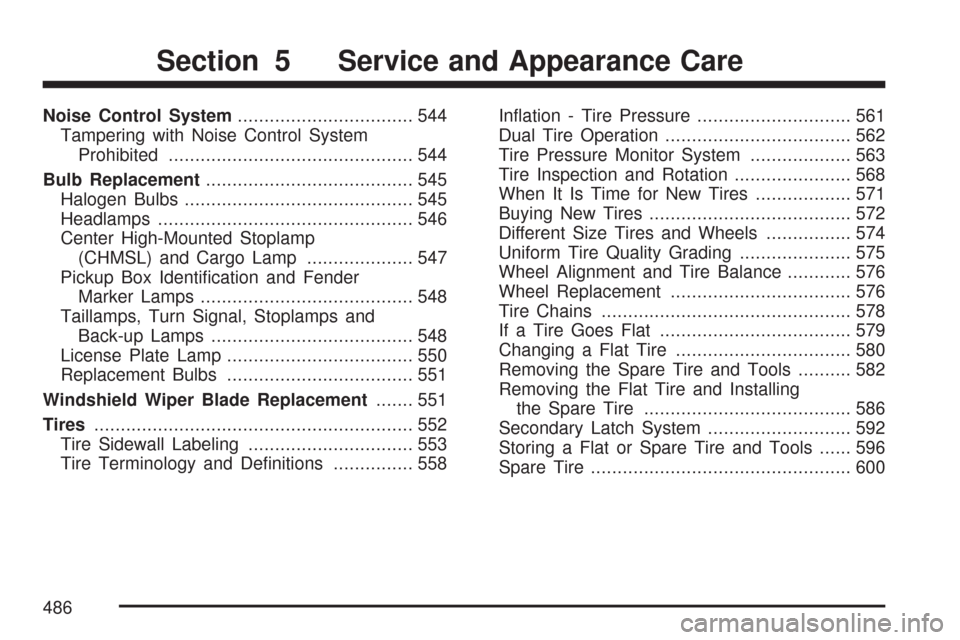
Noise Control System................................. 544
Tampering with Noise Control System
Prohibited.............................................. 544
Bulb Replacement....................................... 545
Halogen Bulbs........................................... 545
Headlamps................................................ 546
Center High-Mounted Stoplamp
(CHMSL) and Cargo Lamp.................... 547
Pickup Box Identi�cation and Fender
Marker Lamps........................................ 548
Taillamps, Turn Signal, Stoplamps and
Back-up Lamps...................................... 548
License Plate Lamp................................... 550
Replacement Bulbs................................... 551
Windshield Wiper Blade Replacement....... 551
Tires............................................................ 552
Tire Sidewall Labeling............................... 553
Tire Terminology and De�nitions............... 558In�ation - Tire Pressure............................. 561
Dual Tire Operation................................... 562
Tire Pressure Monitor System................... 563
Tire Inspection and Rotation...................... 568
When It Is Time for New Tires.................. 571
Buying New Tires...................................... 572
Different Size Tires and Wheels................ 574
Uniform Tire Quality Grading..................... 575
Wheel Alignment and Tire Balance............ 576
Wheel Replacement.................................. 576
Tire Chains............................................... 578
If a Tire Goes Flat.................................... 579
Changing a Flat Tire................................. 580
Removing the Spare Tire and Tools.......... 582
Removing the Flat Tire and Installing
the Spare Tire....................................... 586
Secondary Latch System........................... 592
Storing a Flat or Spare Tire and Tools...... 596
Spare Tire................................................. 600
Section 5 Service and Appearance Care
486
Page 568 of 684

Federal Communications Commission
(FCC) and Industry and Science
Canada
The Tire Pressure Monitor System (TPMS)
operates on a radio frequency and complies with
Part 15 of the FCC Rules. Operation is subject
to the following two conditions:
1. This device may not cause harmful
interference.
2. This device must accept any interference
received, including interference that may
cause undesired operation.
The Tire Pressure Monitor System (TPMS)
operates on a radio frequency and complies with
RSS-210 of Industry and Science Canada.
Operation is subject to the following two
conditions:
1. This device may not cause interference.
2. This device must accept any interference
received, including interference that may
cause undesired operation of the device.
Changes or modi�cations to this system by other
than an authorized service facility could void
authorization to use this equipment.
Tire Inspection and Rotation
Tires should be rotated every 5,000 to 8,000 miles
(8 000 to 13 000 km).
Any time you notice unusual wear, rotate your
tires as soon as possible and check wheel
alignment. Also check for damaged tires or wheels.
SeeWhen It Is Time for New Tires on page 571
andWheel Replacement on page 576for
more information.
Make sure the spare tire is stored securely. Push,
pull, and then try to rotate or turn the tire. If it
moves, use the wheel wrench/hoist shaft to tighten
the cable. SeeChanging a Flat Tire on page 580.
If your vehicle has dual rear wheels, also see
Dual Tire Operation on page 562.
The purpose of regular rotation is to achieve more
uniform wear for all tires on the vehicle. The
�rst rotation is the most important. SeeScheduled
Maintenance (Gasoline Engine) on page 627.
568
Page 570 of 684
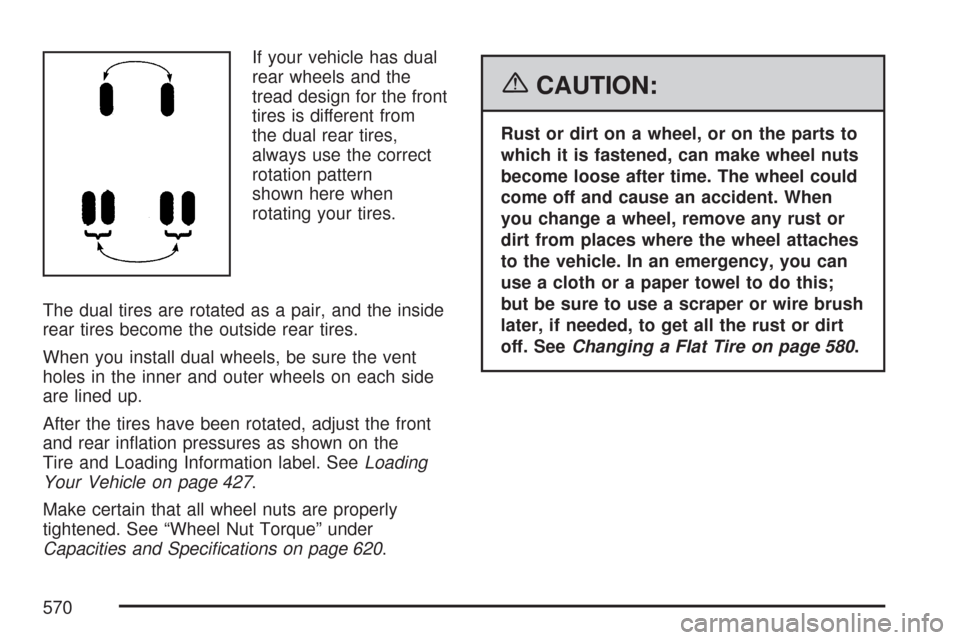
If your vehicle has dual
rear wheels and the
tread design for the front
tires is different from
the dual rear tires,
always use the correct
rotation pattern
shown here when
rotating your tires.
The dual tires are rotated as a pair, and the inside
rear tires become the outside rear tires.
When you install dual wheels, be sure the vent
holes in the inner and outer wheels on each side
are lined up.
After the tires have been rotated, adjust the front
and rear in�ation pressures as shown on the
Tire and Loading Information label. SeeLoading
Your Vehicle on page 427.
Make certain that all wheel nuts are properly
tightened. See “Wheel Nut Torque” under
Capacities and Speci�cations on page 620.
{CAUTION:
Rust or dirt on a wheel, or on the parts to
which it is fastened, can make wheel nuts
become loose after time. The wheel could
come off and cause an accident. When
you change a wheel, remove any rust or
dirt from places where the wheel attaches
to the vehicle. In an emergency, you can
use a cloth or a paper towel to do this;
but be sure to use a scraper or wire brush
later, if needed, to get all the rust or dirt
off. SeeChanging a Flat Tire on page 580.
570
Page 577 of 684

Your dealer will know the kind of wheel you need.
Each new wheel should have the same
load-carrying capacity, diameter, width, offset and
be mounted the same way as the one it
replaces.
If you need to replace any of your wheels, wheel
bolts or wheel nuts, replace them only with
new GM original equipment parts. This way, you
will be sure to have the right wheel, wheel
bolts and wheel nuts for your vehicle.
{CAUTION:
Using the wrong replacement wheels,
wheel bolts, or wheel nuts on your vehicle
can be dangerous. It could affect the
braking and handling of your vehicle,
make your tires lose air and make you
lose control. You could have a collision in
which you or others could be injured.
Always use the correct wheel, wheel bolts,
and wheel nuts for replacement.Notice:The wrong wheel can also cause
problems with bearing life, brake cooling,
speedometer or odometer calibration,
headlamp aim, bumper height, vehicle ground
clearance, and tire or tire chain clearance
to the body and chassis.
Whenever a wheel, wheel bolt or wheel nut is
replaced on a dual wheel setup, check the wheel
nut torque after 100, 1,000 and 6,000 miles
(160, 1 600 and 10 000 km) of driving. For proper
torque, see “Wheel Nut Torque” underCapacities
and Speci�cations on page 620.
SeeChanging a Flat Tire on page 580for more
information.
577
Page 579 of 684
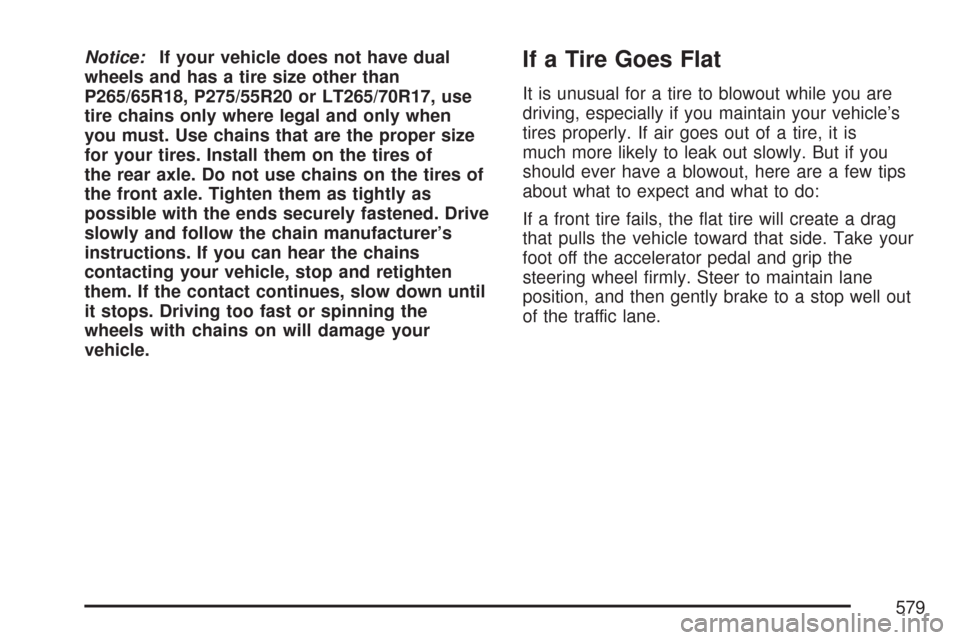
Notice:If your vehicle does not have dual
wheels and has a tire size other than
P265/65R18, P275/55R20 or LT265/70R17, use
tire chains only where legal and only when
you must. Use chains that are the proper size
for your tires. Install them on the tires of
the rear axle. Do not use chains on the tires of
the front axle. Tighten them as tightly as
possible with the ends securely fastened. Drive
slowly and follow the chain manufacturer’s
instructions. If you can hear the chains
contacting your vehicle, stop and retighten
them. If the contact continues, slow down until
it stops. Driving too fast or spinning the
wheels with chains on will damage your
vehicle.If a Tire Goes Flat
It is unusual for a tire to blowout while you are
driving, especially if you maintain your vehicle’s
tires properly. If air goes out of a tire, it is
much more likely to leak out slowly. But if you
should ever have a blowout, here are a few tips
about what to expect and what to do:
If a front tire fails, the �at tire will create a drag
that pulls the vehicle toward that side. Take your
foot off the accelerator pedal and grip the
steering wheel �rmly. Steer to maintain lane
position, and then gently brake to a stop well out
of the traffic lane.
579
Page 580 of 684
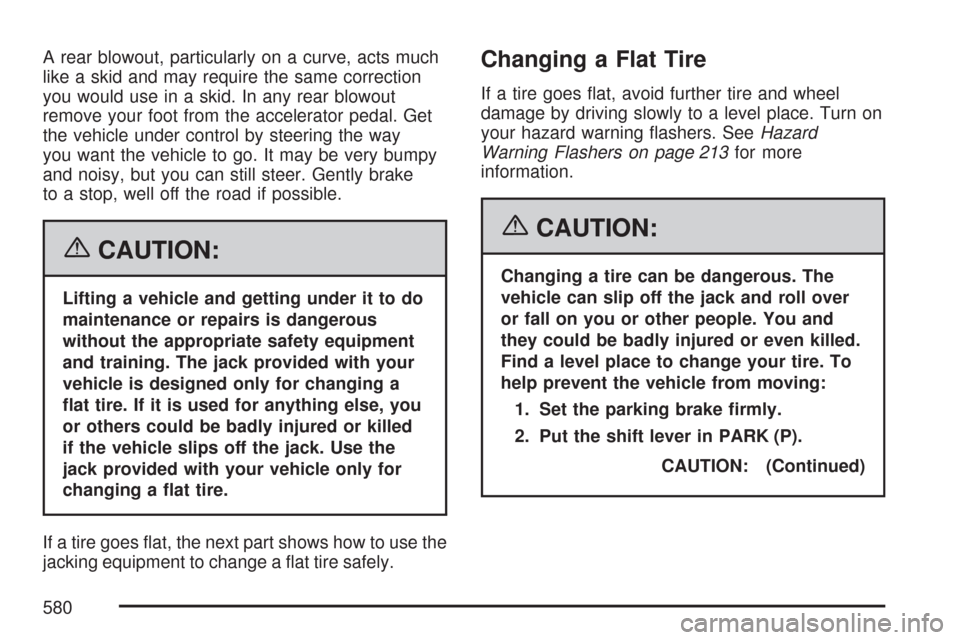
A rear blowout, particularly on a curve, acts much
like a skid and may require the same correction
you would use in a skid. In any rear blowout
remove your foot from the accelerator pedal. Get
the vehicle under control by steering the way
you want the vehicle to go. It may be very bumpy
and noisy, but you can still steer. Gently brake
to a stop, well off the road if possible.
{CAUTION:
Lifting a vehicle and getting under it to do
maintenance or repairs is dangerous
without the appropriate safety equipment
and training. The jack provided with your
vehicle is designed only for changing a
�at tire. If it is used for anything else, you
or others could be badly injured or killed
if the vehicle slips off the jack. Use the
jack provided with your vehicle only for
changing a �at tire.
If a tire goes �at, the next part shows how to use the
jacking equipment to change a �at tire safely.
Changing a Flat Tire
If a tire goes �at, avoid further tire and wheel
damage by driving slowly to a level place. Turn on
your hazard warning �ashers. SeeHazard
Warning Flashers on page 213for more
information.
{CAUTION:
Changing a tire can be dangerous. The
vehicle can slip off the jack and roll over
or fall on you or other people. You and
they could be badly injured or even killed.
Find a level place to change your tire. To
help prevent the vehicle from moving:
1. Set the parking brake �rmly.
2. Put the shift lever in PARK (P).
CAUTION: (Continued)
580
Page 586 of 684
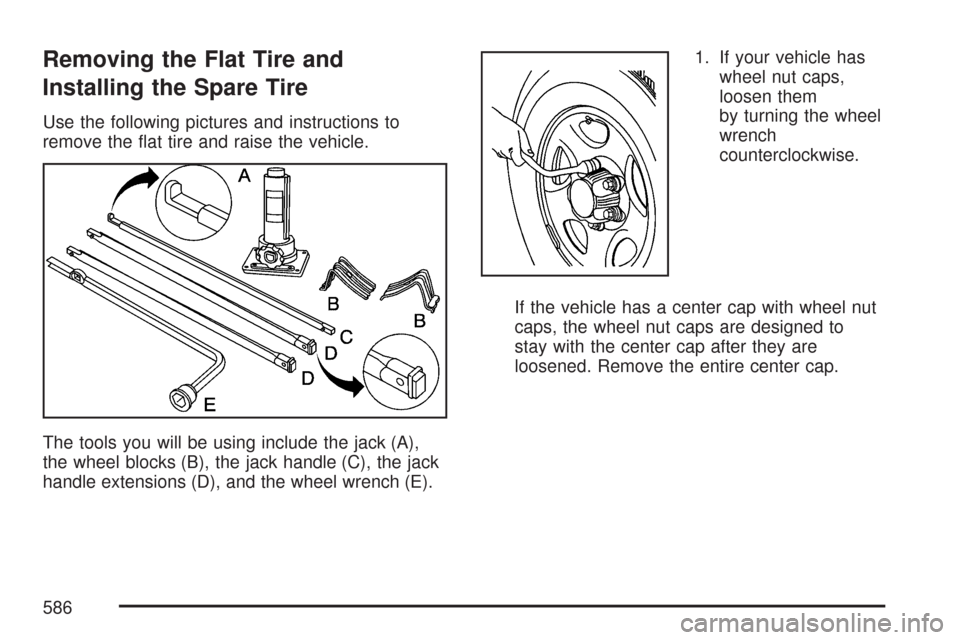
Removing the Flat Tire and
Installing the Spare Tire
Use the following pictures and instructions to
remove the �at tire and raise the vehicle.
The tools you will be using include the jack (A),
the wheel blocks (B), the jack handle (C), the jack
handle extensions (D), and the wheel wrench (E).1. If your vehicle has
wheel nut caps,
loosen them
by turning the wheel
wrench
counterclockwise.
If the vehicle has a center cap with wheel nut
caps, the wheel nut caps are designed to
stay with the center cap after they are
loosened. Remove the entire center cap.
586
Page 592 of 684
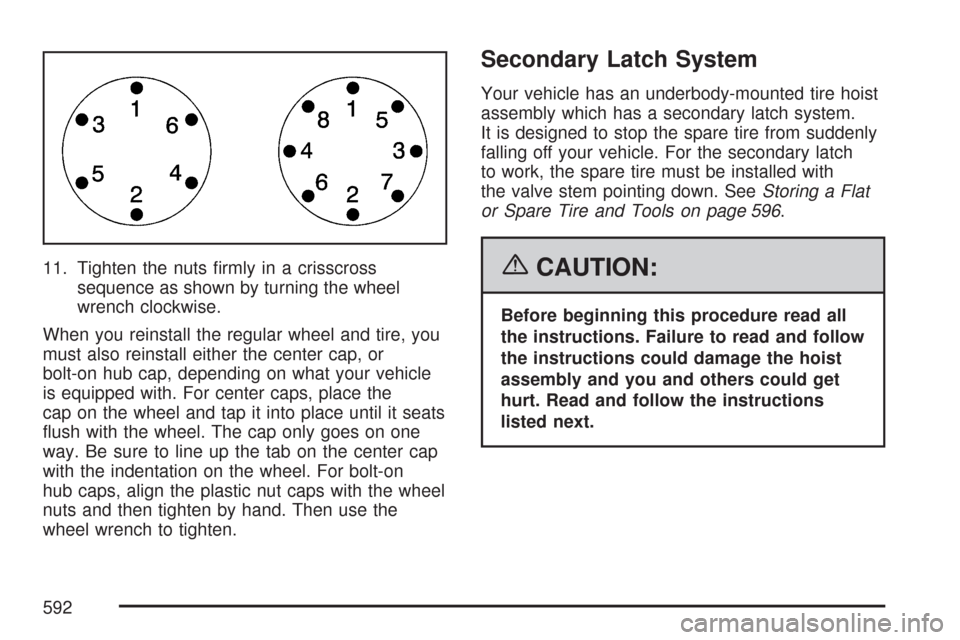
11. Tighten the nuts �rmly in a crisscross
sequence as shown by turning the wheel
wrench clockwise.
When you reinstall the regular wheel and tire, you
must also reinstall either the center cap, or
bolt-on hub cap, depending on what your vehicle
is equipped with. For center caps, place the
cap on the wheel and tap it into place until it seats
�ush with the wheel. The cap only goes on one
way. Be sure to line up the tab on the center cap
with the indentation on the wheel. For bolt-on
hub caps, align the plastic nut caps with the wheel
nuts and then tighten by hand. Then use the
wheel wrench to tighten.
Secondary Latch System
Your vehicle has an underbody-mounted tire hoist
assembly which has a secondary latch system.
It is designed to stop the spare tire from suddenly
falling off your vehicle. For the secondary latch
to work, the spare tire must be installed with
the valve stem pointing down. SeeStoring a Flat
or Spare Tire and Tools on page 596.
{CAUTION:
Before beginning this procedure read all
the instructions. Failure to read and follow
the instructions could damage the hoist
assembly and you and others could get
hurt. Read and follow the instructions
listed next.
592